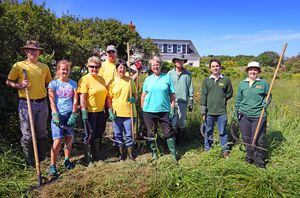Digging it
TUCKED away in one of the most populated and industrialised parts of the island, the Marais Rise reed bed is a natural haven for wildlife.

Every day thousands of road users pass by this little green pocket of land, blissfully unaware of its location close to the busy Red Lion filter.
The reed bed is one of a number of special, often overlooked sites that are cared for and maintained on a regular basis by the Guernsey Conservation Volunteers.
Before these unpaid guardians of our precious green spaces turned up at Marais Rise seven years ago, the whole area was in a very sorry looking state.
‘This was a horrible bit of wasteground, really,’ recalled GCV co-ordinator Angela Salmon, who was one of the first on the scene.
‘It had been fly-tipped horribly and it was very overgrown with brambles, so we started with a couple of skips for green waste and a skip for rubbish.
‘It was like that for quite a while, but now we’re on a maintenance programme. We’ve actually cleared the whole reed bed over the years and now we just clear parts of it and maintain it.’
The conservation volunteers, who come from all walks of island life, meet for a couple of hours on Saturday mornings throughout the year to do their bit for the environment.
They get no financial reward for their labours, but they do gain a tremendous amount of satisfaction from their outdoor efforts helping nature to flourish.
The Marais Rise reed bed is States-owned land but they also carry out their conservation work on land owned or managed by the National Trust and La Societe Guernesiaise.
As well as the reed bed near Town, they look after a dozen or so other green sites dotted around the island from Torteval to Jerbourg to L’Ancresse.
It all started in 1996 with a small group of people who decided to band together to spruce up one or two neglected parcels of public land.
Angela joined 13 years ago and she has been the group’s main organiser for the last 10 years.
‘I’d done a conservation project out in the Peruvian Amazon and then came back to Guernsey and saw an article in the Press about the Guernsey Conservation Volunteers.
‘I thought I’d give it a go and as soon as I went along I was taken by it. I thought, this is what I want to do because it’s conservation work I can do every other weekend at different places around Guernsey.
‘Straight away I was going out and finding places that I didn’t know existed. You can live on an island for years but there are loads of places you don’t realise that are hidden away.’
Last year the Guernsey Conservation Volunteers marked their 21st anniversary with a series of social events including a Christmas party and a summer outing to Herm.
The membership has fluctuated over the last two decades and now stands at around 20, with a core group of around 10 to 12 who turn out almost every fortnight throughout the year.
‘We could do with some more volunteers, but our numbers generally increase in the winter because it gives people a purpose to go out.
‘People in the summer might be on holiday or they might go to the beach or they might have a boat, so there are lots of things in the summer that are a pull on people doing other things.
‘In the winter if it’s a cold day you need a real reason to go outside, and once you start working you’re plenty warm enough.’
Teacher Angela spends most of her working days in a classroom and there are quite a few office workers who, like her, relish the prospect of getting out for a couple of hours of honest physical endeavour.
‘A lot of people actually work indoors during the week so they want to come outside with a purpose for the weekend.
‘The commitment is up to the individual completely. Some people we see virtually every work party and other people we see every six months or so.
‘Anybody is welcome, no experience is necessary and you don’t have to be committed to doing it every week. Any hours that people can commit is good.’
The volunteers pay a £5 annual subscription to become members. For that they get insurance cover as well as their personal gardening gloves and a T-shirt, plus the free biscuits that are an essential part of the tea break.
The GCV way of working is to do everything manually and there is no sign of any mechanised equipment apart from the van that brings all the tools that they will need, depending on the job.
The volunteers work with the seasons, doing mostly clearance during the autumn and winter months, hacking and cutting back in preparation for the first surge of spring growth.
Last month they had two very productive sessions at the Garenne Nature Reserve, just off Rue a Chiens in St Sampson’s, cutting back the growth in the moat on behalf of La Societe Guernesiaise.
This month they have turned their attention to removing Alexander plants from the orchid meadow at Jerbourg in St Martin’s and on the first Saturday of March they go to Le Bigard in the Forest to do tree work.
In spring or early summer you will find the conservation volunteers at work in the island’s orchid fields near L’Eree, removing the hemlock water dropwort plants.
These fields require constant management, but the volunteers have been able to make a permanent difference at Fort Pezeries near Pleinmont Point, clearing the invasive hottentot figs.
‘We still occasionally go down to check because that was such a successful site for us that we don’t want it to revert to hottentot,’ Angela smiled.
‘All the native plants are there now, which is just fantastic and great for biodiversity.’
u The next GCV work party is on Saturday 3 March at 10am, when the volunteers will be doing tree work at Le Bigard in the Forest. To find out how to take part or to learn more about the work of the Guernsey Conservation Volunteers, visit www.gcv.org.uk.





